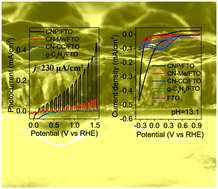In situ growth of triazine–heptazine based carbon nitride film for efficient (photo)electrochemical performance†
Abstract
The inherent properties of carbon nitride and the preparation of its (photo)electrode are essential for the efficient conversion of solar energy or electricity into chemical energy in solar hydrogen production. We report the successful in situ growth of a compact carbon nitride polymer (CNP) 2D film with a triazine–heptazine network fragment on FTO (CNP/FTO) through an evaporation polymerization method at a relatively low temperature (450 °C) using melamine and cyanuric chloride as precursors. The CNP film makes intimate contact with the FTO substrate via covalent linkage of s-triazine units and FTO, which ensures more efficient interfacial charge transport. The triazine–heptazine network of CNPs allows stronger visible-light harvesting and more effective charge separation and transfer. As such, the prepared CNP/FTO photoelectrode exhibits excellent PEC performance. Its photocurrent density is around 230 μA cm−2 at 1.23 V vs. RHE, which is 7.5, 176.9 and 67.6 times that of CN-Me/FTO, CN-CC/FTO, and g-C3N4/FTO, respectively, under simulated solar irradiation (1 sun, AM 1.5) without sacrificial reagents and cocatalysts (CN-Me/FTO and CN-CC/FTO were prepared using melamine and cyanuric chloride alone as precursor, respectively, and g-C3N4/FTO was fabricated by gluing bulk g-C3N4 powders onto a FTO substrate). Compared with previously reported metal-free carbon nitride photoanodes, our CNP film shows the best PEC performance and lower preparation temperature. Further, the prepared CNP/FTO film can be used as an economic and potential metal-free material for the electrocatalytic hydrogen evolution reaction (HER). The CNP/FTO electrode shows higher activity in the HER with low overpotential and acceptable current densities as compared to g-C3N4/FTO, CN-CC/FTO, and CN-Me/FTO electrodes, which is attributed to the strong contact of compact CNP film with FTO and the increased number of terminal amino groups of CNPs.



 Please wait while we load your content...
Please wait while we load your content...